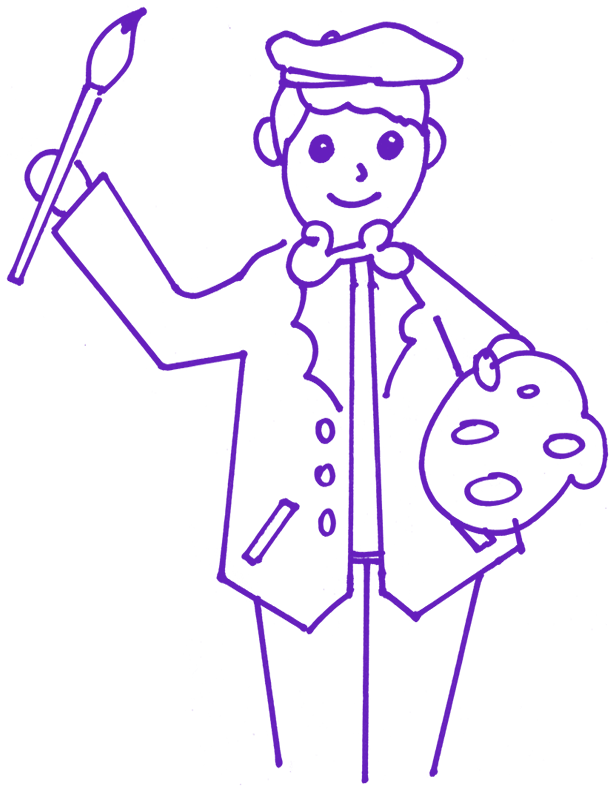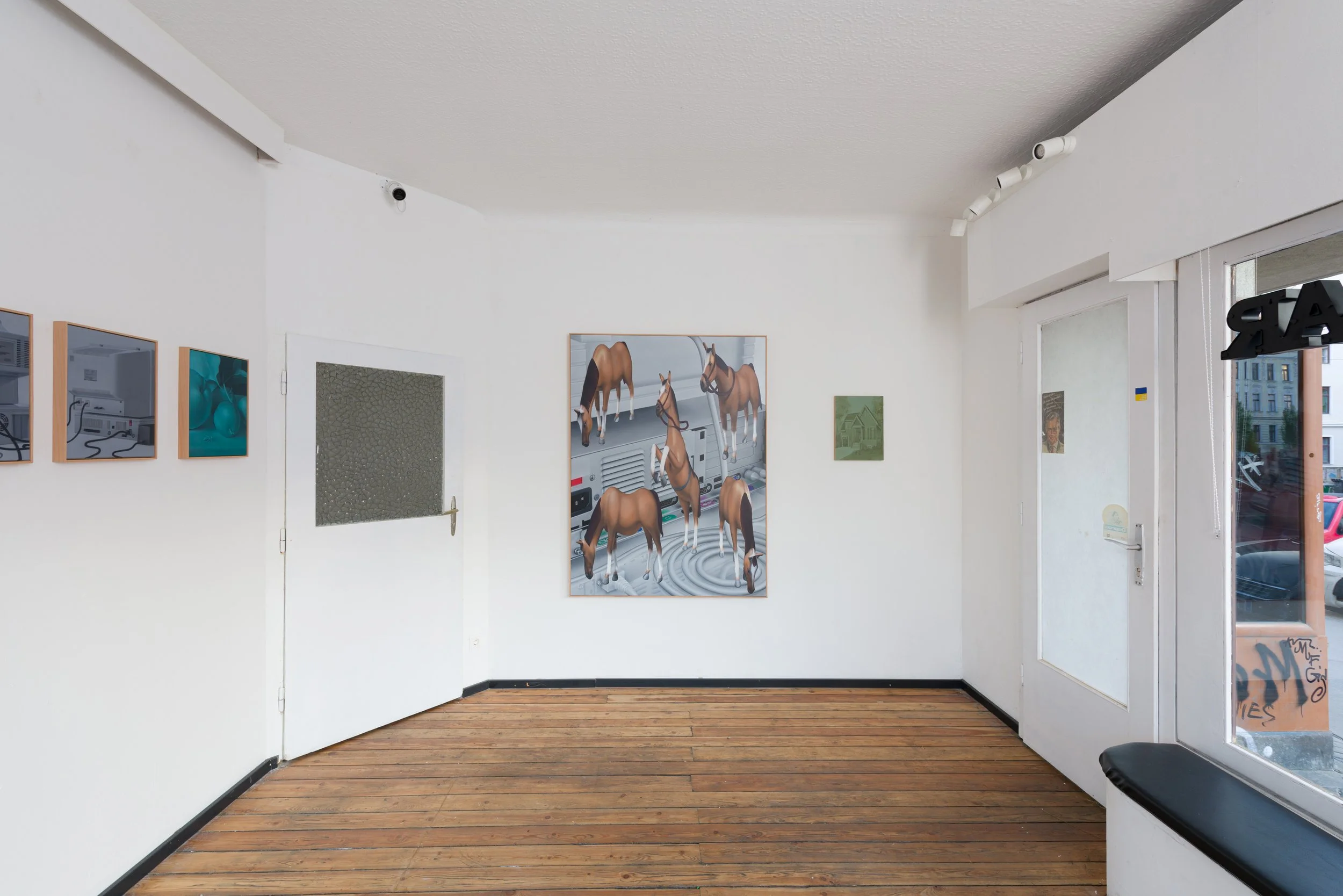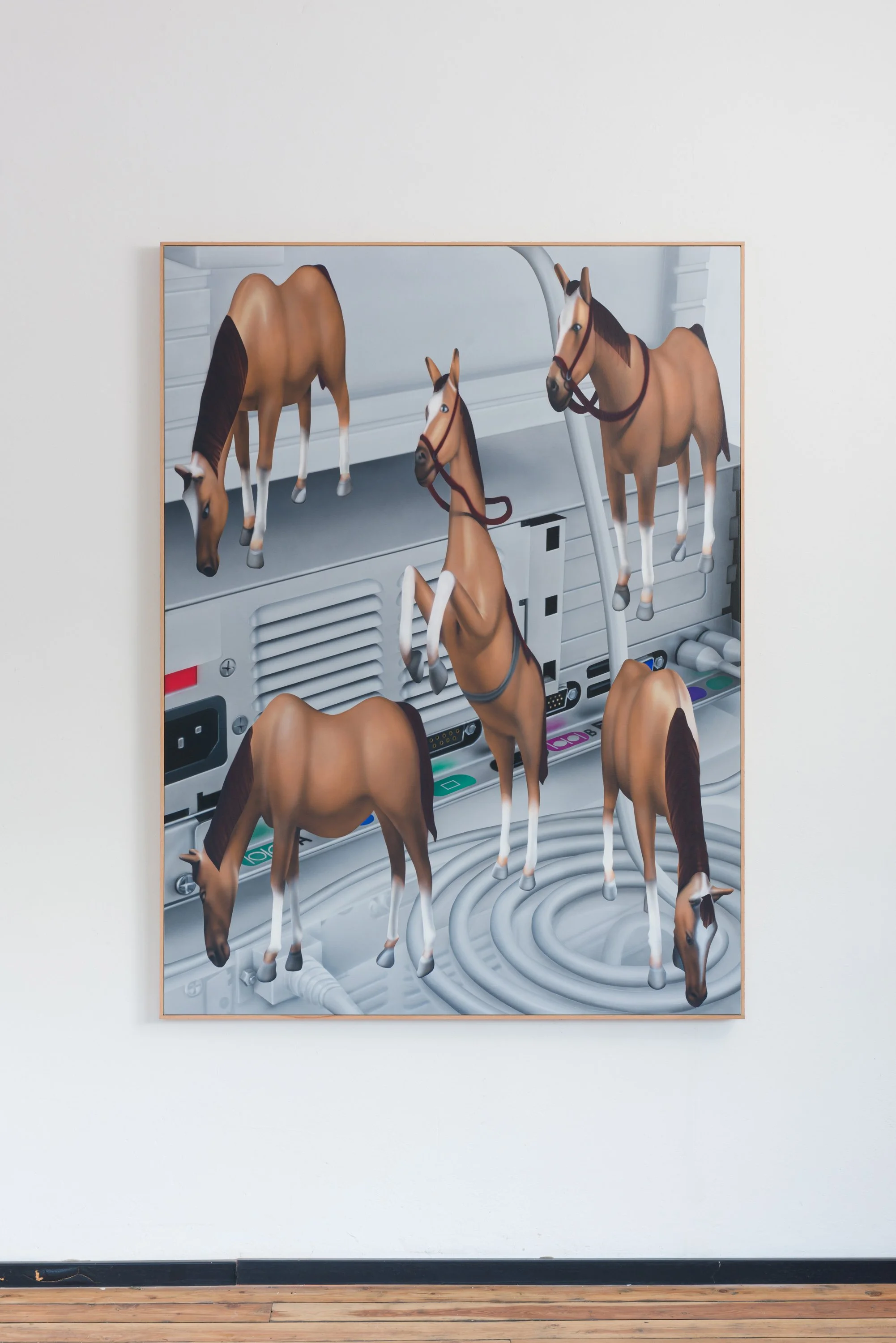Outward Appearance
About Paul Riedmüller’s work
Text by Simon Goritschnig, 2022
Viewing Paul Riedmüller’s paintings immediately makes it clear, that you need your eyes to do so. Bright colors and clear tones confront your sensors, while shiny gradients and high contrasts stimulate your vision. What we see is very distinct; it is not only a mere prerequisite of his work, but also the question it poses to us viewers.
In Landschaft (Landscape), a large scale format painted in acrylic on canvas, this applies especially well. We see a central perspective, composed of one main subject: a lonely house. Shades of violet; monochrome melancholy behind a veil of wet glass. Hyper-realistic raindrops dominate this shot, and while the blurred silhouette of an unattainable Beverly Hills villa fades unnaturally soft into its background, rain is flowing down a transparent panel in front of us. The drops are airbrushed, each of them reflecting a subtle light that is not really there. Utopia, protection… comfort in a world of hustle that may forever be out of reach. Although the painting makes sense from afar, we are almost too close now. The details pull us in, but there is more yet to see. All of this is pinned down by four smaller boxes in each corner of the image, each one a perfect copy of the same photograph – a landscape. It looks like stock photos overlapping, a very simple task in Photoshop… but painted?
In an interplay of a multiplicity of media, Riedmüller makes use of all the visual techniques he can get a hold on to create collages filled with pop-cultural references. His iPad is therefore as important to this workflow as 3D software, Google Streetview or the ubiquitous airbrush. Layers upon layers overlap as he carefully combines his own images with found footage, just to partially hide them under wild gestures of spray paint or soft coatings of lacquers, varnishes and stencils. Mastering the technicalities of the painter’s craft in the middle of an overflowing world of possibilities is one of Riedmüllers focus points.
Blumen (Flowers) makes this deliberate stacking of information apparent, as the artist aims to confuse anyone attempting to deconstruct the dense web of his process. In a wild composition that somehow fuses a flower bouquet with action painting, we find a small area of geometric calmness that seems to stick out from the otherwise warm palette of burgundy and blue. ”Could it be useful, or even necessary” – we ask ourselves – “to view this through the screens of our mobile phones?” In times like these, when paintings are often composed to function especially well in the square rulesets of social media, this could be true. Only when inverted, virtually, the upper part of Flowers reveals its content to the beholder. A painting about painting, but digitally.
And why not? Working with traditional techniques in the 21st century begs for being questioned. Through directly addressing the medium that normally delivers his message, Riedmüller confronts the viewer with an immediate moment of self-reflection.
When we see hundreds and hundreds of paintings everyday through the artificial lenses of our phones, we lose touch with the phenomenon of light, or the viscosity of thick strokes and subtle gestures. What we see is what we get, but we get nothing out of it. Our eyes are being fed to death, until the point where the digital keeps pushing us out into the sunshine. Then we call it digital detox, when it is in fact only a necessity; fighting for our psychic health in the clarity of an insta-free-afternoon.
In the act of painting Riedmüller processes his daily life within the internet in his own way. Pixels, LEDs and the physics of the screen are an integral part of his visual vocabulary.
Through this approach he creates intricate compositions that sometimes resemble the random order of tabs and windows in computer interfaces. They are challenging to the eyes and they often don’t fit into the classical definition of fine art imagery – but it’s not beauty he aims for, it’s playful experimentation.
Computer 1 and Computer 2: We see two grey boxes – brushed reproductions of 3D-renderings showing outdated devices. They turn their back on us, and while their screens hide from their viewers, we may only wonder about the low resolution that is being emitted by the processors in their cases. These paintings transport us back into an era full of nostalgia, a time when surfing the net still produced melodies. The clicking sound of expectation; the bumping of waiting fingers against desks. These works are odes to the 90’s, when pixels were still a thing and not only unique selling points of indie-game productions. As an artist you had to choose your colors wisely. Not only for aesthetic reasons, but to be loaded more efficiently.
This too, is our shared history: the years we spend together, watching the loading bar of Windows 98. These times unite us with the rest of the digital era, as we now look at Riedmüller’s old computers. It’s the shared experience of surfing the web: a language that speaks in archetypes, echoes of the past like the vanitas or the classical tablecloth with a fruit bowl and wineglass on top.
His images are constructed from everyday objects and recurring assets that can be interchanged at will. Stillleben 1 (Still Life), Stillleben 2 and Totenkopf (Skull) are perfect examples of this - even their titles. They are not painted from real life, but instead are painted from digital screens. Digital images that the artist created with help of 3D-software, just for the sole purpose of being reproduced. A meticulous process, reflecting upon the digital world we are confronted with everyday. He presents us with a reality made up from building-blocks, rather than personas. And so these still lifes gain an uncanny attitude. Lifeless in a way, and unreal, like wax cabinets.
Everything seems to be just a proxy of some other painting, a stand in for the real thing to come. These paintings formulate in between Western art history and globalized hyper capitalism, and they show the struggle of not exactly knowing where art belongs in today’s world.
Paul Riedmüller’s paintings play tricks on our minds - as well as on our eyes. While looking becomes searching we scan the surface for possible mistakes - in the absence of which these blemishless canvases act like the facade they portray so well. Nothing is perfect in this world, although it sometimes wants to make us think so. In these works his style is reminiscent of the depersonalized shading of Christian Schad. Almost too clean to stand; a world that’s sterile… like industry for the masses. In a very contradictory way, Riedmüller reminds us of one thing. We see a lot of seriousness, but in fact, everything is a game.
The same is true for his other painting Pferde (Horses). While funky mares and stallions populate the scene, the title keeps its promise: The beauty of those animals, their perfect poses, the ease of their color’s application… and again, this feeling of nostalgia. School yard trading, ponies, Wendy. Gracing peacefully in this Silicon Valley, these mounts look like straight out of a fairytale, their fur glittering and perfectly surreal in the cold grey of its surrounding. What makes this scene so bewildering is not the subjects of its content, but how they are presented. Like stickers in an album of collectibles, these horses are floating in the midst of air, while others seem to be grounded by gravity. Through the lack of any shadowing, one thing becomes apparent: there is a certain beauty in it, lightness even, that one can not ignore. Horses is not about horses at all. It is about playfulness, fantasy and how we see the world. It is about the possibility of everything in a world of art and imagination.
“outward Appearance”
Solo Exhibition @ Boutique Romana, Vienna 2022
Photos by: Christoph Schlessmann







